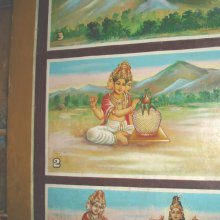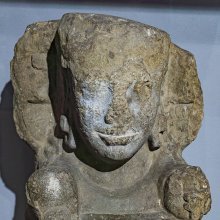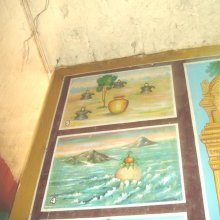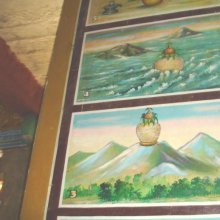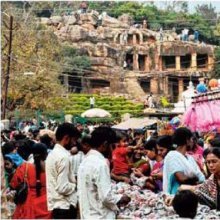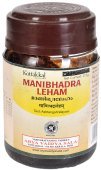Kumbha: 51 definitions
Introduction:
Kumbha means something in Buddhism, Pali, Hinduism, Sanskrit, Jainism, Prakrit, the history of ancient India, Marathi, Hindi, biology. If you want to know the exact meaning, history, etymology or English translation of this term then check out the descriptions on this page. Add your comment or reference to a book if you want to contribute to this summary article.
Images (photo gallery)
(+10 more images available)
In Hinduism
Shilpashastra (iconography)
Source: Google Books: The Theory of Citrasutras in Indian PaintingKumbha (कुम्भ, ‘pot’) is a weapon (āyudha or bādhra) according to the Vāstusūtra Upaniṣad.
Source: Shodhganga: The significance of the mūla-beras (śilpa)Kumbha (“pot”) refers to one of the several “attributes” (āyudha) or “accessories” of a detiy commonly seen depicted in Hindu iconography, defined according to texts dealing with śilpa (arts and crafs), known as śilpaśāstras.—The śilpa texts have classified the various accessories under the broad heading of āyudha or karuvi (implement), including even flowers, animals, and musical instruments. The other miscellaneous articles found as attributes in the hands of the deities are, for example, Kumbha.

Shilpashastra (शिल्पशास्त्र, śilpaśāstra) represents the ancient Indian science (shastra) of creative arts (shilpa) such as sculpture, iconography and painting. Closely related to Vastushastra (architecture), they often share the same literature.
Vastushastra (architecture)
Source: Wisdom Library: Vāstu-śāstra1) Kumbha (कुम्भ) refers to classification of a temple/buidling (prāsāda), according to Samarāṅgaṇasūtradhāra chapter 63. The temple is mentioned being part of the group named Nāgara, which contains twenty different Prāsādas (temples/buildings). The Samarāṅgaṇasūtradhāra is an 11th-century encyclopedia dealing with various topics from the Vāstuśāstra.
Kumbha is found in another list in the Samarāṅgaṇasūtradhāra, chapter 60, where it is mentioned in a list of thirty-six Prāsādas (temples) having activities of the townsmen entailing Sādhārās.
Kumbha is also listed in the Īśānaśivagurudevapaddhati which features a list of 52 temple types. This list represents the classification of temples in South-India.
Kumbha is also listed in the Matsyapurāṇa which features a list of 20 temple types. This list represents a classification of temples in Nort-India.
2) Kumbha (कुम्भ) refers to “capital”. It is sculptured as a part of the pillar (stambha).
3) Kumbha (कुम्भ) corresponds with the Aquarius zodiac sign and refers to the eleventh of twelve rāśi (zodiacal sign), according to the Mānasāra. Rāśi is one of the three alternative principles, besides the six āyādiṣaḍvarga, used to constitute the “horoscope” of an architectural or iconographic object. Their application is intended to “verify” the measurements of the architectural and iconographic object against the dictates of astrology that lay out the conditions of auspiciousness.
The particular rāśi (e.g., kumbha) of all architectural and iconographic objects (settlement, building, image) must be calculated and ascertained. This process is based on the principle of the remainder. An arithmetical formula to be used in each case is stipulated, which engages one of the basic dimensions of the object (breadth, length, or perimeter/circumference). All twelve rāśis, except the eighth (vṛścika) are auspicious.
Source: Shodhganga: Temples of Salem region Up to 1336 ADKumbha (कुम्भ).—One of the components of a kumbhapañjara (a decorative motif);—Kumbha is the pot base, which is generally placed on a pedestal, which may be circular or square and may be ornate or non-ornate. The kumbha is generally globular and some times it is cuboid with its two comers ridged and sides rounded. The body of the pot is often decorated with a fillet, ratnapaṭṭika, puṣpapaṭṭika, vajrapaṭṭika, etc.
Source: OpenEdition books: Architectural terms contained in Ajitāgama and RauravāgamaKumbha (कुम्भ) refers to “- 1. torus (molding) § 3.7. - 2. marquee §§ 3.18-20. - 3. marquee basket (Aj) § 3.19. - 4. vase (main molding of the crown motif) (Aj) § 3.31. - 5. reason for coronation (Aj) § 3.30.”.—(For paragraphs cf. Les enseignements architecturaux de l'Ajitāgama et du Rauravāgama by Bruno Dagens)

Vastushastra (वास्तुशास्त्र, vāstuśāstra) refers to the ancient Indian science (shastra) of architecture (vastu), dealing with topics such architecture, sculpture, town-building, fort building and various other constructions. Vastu also deals with the philosophy of the architectural relation with the cosmic universe.
Purana and Itihasa (epic history)
Source: Wisdom Library: Varāha-purāṇaKumbha (कुम्भ) is the name of a mountain situated at lake Aruṇoda and mount Mandara, according to the Varāhapurāṇa chapter 75. The Mandara mountain lies on the eastern side of mount Meru, which is one of the seven mountains located in Jambūdvīpa, ruled over by Āgnīdhra, a grandson of Svāyambhuva Manu, who was created by Brahmā, who was in turn created by Nārāyaṇa, the unknowable all-pervasive primordial being.
Source: archive.org: Puranic Encyclopedia1) Kumbha (कुम्भ).—One of the three sons of Prahlāda, the other two being Virocana and Nikumbha. (Ādi Parva, Chapter 65, Verse 19).
2) Kumbha (कुम्भ).—Son of Kumbhakarṇa, whose wife Vajrajvālā bore him two sons called Kumbha and Nikumbha. Both of them were very powerful, and Kumbha, in the Rāma-Rāvaṇa war defeated the army of monkeys on various occasions. Many of the ministers of Sugrīva tried to defeat Kumbha. Aṅgada, son of Bāli also could not stand up to him. Then Sugrīva fought against Kumbha and flung him into the sea when the water in it rose up to the level of mount Vindhya. Kumbha came ashore from the sea roaring but was fisted to death by Sugrīva. (Vālmīki Rāmāyaṇa, Yuddha Kāṇḍa, Canto 76).
Source: Cologne Digital Sanskrit Dictionaries: The Purana Index1a) Kumbha (कुम्भ).—A Daitya king, originator of the kāpileyas, Daityarākṣasas; by his wife Kapilā;1 killed in the Laṅkā war.2
1b) A son of Muṇḍīśvara, an avatār of the lord of the 25th dvāpara.*
- * Vāyu-purāṇa 23. 211.
1c) Helped Soma in the Tārakāmaya war.*
- * Viṣṇu-purāṇa IV. 6. 14.
1d) A palace in the shape of a pot, with 9 bhūmikas and a toraṇa of 16 hastas.*
- * Matsya-purāṇa 269. 37-49.
1e) Fit for śrāddha.*
- * Vāyu-purāṇa 77. 47.
1f) A water vessel, being an adjunct of vratas to be given as gift.*
- * Matsya-purāṇa 7. 10 and 18.
Kumbha (कुम्भ) is a name mentioned in the Mahābhārata (cf. I.59.19, I.65) and represents one of the many proper names used for people and places. Note: The Mahābhārata (mentioning Kumbha) is a Sanskrit epic poem consisting of 100,000 ślokas (metrical verses) and is over 2000 years old.

The Purana (पुराण, purāṇas) refers to Sanskrit literature preserving ancient India’s vast cultural history, including historical legends, religious ceremonies, various arts and sciences. The eighteen mahapuranas total over 400,000 shlokas (metrical couplets) and date to at least several centuries BCE.
Vaishnavism (Vaishava dharma)
Source: Pure Bhakti: Arcana-dipika - 3rd EditionKumbha (कुम्भ) corresponds to “aquarius” (mid February to mid March) and refers to one of the zodiac signs (rāśī) in the Vedic calendar.—Rāśī refers to the different signs of the zodiac through which the sun travels. For precise dates, please refer to a Vedic calendar. In accordance with the zodiac sign the sun is situated in, one would utter [for example, kumbha-rāśī sthite bhāskare]

Vaishnava (वैष्णव, vaiṣṇava) or vaishnavism (vaiṣṇavism) represents a tradition of Hinduism worshipping Vishnu as the supreme Lord. Similar to the Shaktism and Shaivism traditions, Vaishnavism also developed as an individual movement, famous for its exposition of the dashavatara (‘ten avatars of Vishnu’).
Ayurveda (science of life)
Toxicology (Study and Treatment of poison)
Source: Shodhganga: Kasyapa Samhita—Text on Visha ChikitsaKumbha (कुम्भ) or Kumbhamaṇḍalī refers to one of the sixteen varieties of Maṇḍalī snakes, according to the Kāśyapa Saṃhitā: an ancient Sanskrit text from the Pāñcarātra tradition dealing with both Tantra and Viṣacikitsā—an important topic from Āyurveda which deals with the study of Toxicology (Viṣavidyā or Sarpavidyā).—Kāśyapa sources his antidotes from a multitude plants, a few minerals, salts and animal products available in nature. All these plants fall under various groups called gaṇas, as pronounced by the Ayurvedic Nigaṇṭus.
Unclassified Ayurveda definitions
Source: gurumukhi.ru: Ayurveda glossary of termsKumbha (कुम्भ):—1. A unit of Measurement; Two combined drona will make one kumbha = 24. 576 kg / l of metric units 2. an earthen pot used for processing & storing the material

Āyurveda (आयुर्वेद, ayurveda) is a branch of Indian science dealing with medicine, herbalism, taxology, anatomy, surgery, alchemy and related topics. Traditional practice of Āyurveda in ancient India dates back to at least the first millenium BC. Literature is commonly written in Sanskrit using various poetic metres.
Jyotisha (astronomy and astrology)
Source: Wisdom Library: Brihat Samhita by Varahamihira1) Kumbha (कुम्भ) refers to a “pot”, according to the Bṛhatsaṃhitā (chapter 4), an encyclopedic Sanskrit work written by Varāhamihira mainly focusing on the science of ancient Indian astronomy astronomy (Jyotiṣa).—Accordingly, “The moon (candra) is always below (nearer to the Earth than) the sun. It is spherical in shape. One half of it is always illumined by the light of the sun, while the other half is dark owing to its own shadow, just like a pot [i.e., kumbha] placed in the sun. The rays of the sun falling on the watery moon remove the darkness of the night (on Earth) just in the same way as light reflected from a mirror (placed in the sun) removes the darkness (from) within a room”.
2) Kumbha (कुम्भ) refers to the sign of Aquarius, according to the Bṛhatsaṃhitā (chapter 5).—Accordingly, “If the sun and moon should begin to be eclipsed when only half risen, deceitful men will suffer as well as sacrificial rites. [...] If they should be eclipsed when in the sign of Aquarius (Kumbha), hill men, men of western countries, carriers, robbers, shephards, serpents, worthy men, lions, citizens and the people of Barbara will perish”.

Jyotisha (ज्योतिष, jyotiṣa or jyotish) refers to ‘astronomy’ or “Vedic astrology” and represents the fifth of the six Vedangas (additional sciences to be studied along with the Vedas). Jyotisha concerns itself with the study and prediction of the movements of celestial bodies, in order to calculate the auspicious time for rituals and ceremonies.
Shaivism (Shaiva philosophy)
Source: Brill: Śaivism and the Tantric Traditions (philosophy)Kumbha (कुम्भ) refers to “(that which is) intrinsically linked”, according to the Vṛtti on the Īśvarapratyabhijñāvivṛtivimarśinī 2.163.—Accordingly, “To the [question:] ‘But how is it that in the cognition that the clay is a cause with respect to the pot, [we] apprehend the seed too as a cause?,’ [Utpaladeva] replies [with the expression] ‘that which is intrinsically linked [with the notion of cause in general].’ And this intrinsic link arises from the manifestation of the generality [consisting in] causality—this is what [Utpaladeva] means”.
Source: Brill: Śaivism and the Tantric Traditions1) Kumbha (कुम्भ) or Surākumbha refers to a “wine (pot)”, according to the 13th-century Matsyendrasaṃhitā: a Kubjikā-Tripurā oriented Tantric Yoga text of the Ṣaḍanvayaśāmbhava tradition from South India.—Accordingly, “If he sees anybody who is abusing the Guru, he should beat him or [at least] curse him. Or, if he is unable [to do so], he should leave the place. He should not ridicule the worship of the [Yoginī] clans, or despise Yogins or Yoginīs, women when they are intoxicated, or nourished, or the wine-pot (surā-kumbha), or Śiva, or the Guru”.
2) Kumbha (कुम्भ) or Svarṇakumbha refers “(golden) jars”, according to the 13th-century Matsyendrasaṃhitā: a Kubjikā-Tripurā oriented Tantric Yoga text of the Ṣaḍanvayaśāmbhava tradition from South India.—Accordingly, “[Visualisation of Śakti]:—[...] The tilaka-mark on her forehead is made with musk thickened with camphor. She has lotus-eyes. She is adorned with rings, armlets, anklets, necklaces etc. Her beautiful lotus face resembles the spotless moon. Her mouth is filled with betel. Her breasts are like golden jars (svarṇa-kumbha). [...]”.
Source: SOAS University of London: Protective Rites in the Netra TantraKumbha (कुम्भ) refers to a “pot” (with a spout), according to the Netratantra of Kṣemarāja: a Śaiva text from the 9th century in which Śiva (Bhairava) teaches Pārvatī topics such as metaphysics, cosmology, and soteriology.—Accordingly, [verse 6.36cd-45, while describing rituals involving the śaśimaṇḍala]—“[...] Then, after [the Mantrin] has honored [Mṛtyujit], with a great and auspicious battle-cry, he anoints [the sick person] on the head, [with a substance from] from a pot (kumbha) with a spout that resembles a white lotus, filled with water that contains jewels, [and includes] all kinds of [medicinal] herbs. [Originally] afflicted by various disease, he is [now] liberated, there is no doubt”.

Shaiva (शैव, śaiva) or Shaivism (śaivism) represents a tradition of Hinduism worshiping Shiva as the supreme being. Closely related to Shaktism, Shaiva literature includes a range of scriptures, including Tantras, while the root of this tradition may be traced back to the ancient Vedas.
Shaktism (Shakta philosophy)
Source: Brill: Śaivism and the Tantric Traditions (shaktism)Kumbha (कुम्भ) refers to a “pitcher”, according to the King Vatsarāja’s Pūjāstuti called the Kāmasiddhistuti (also Vāmakeśvarīstuti), guiding one through the worship of the Goddess Nityā.—Accordingly, “[...] Her body is beautiful and bears the hue of vermillion. Its middle part is slim, [and] she is the repository of beauty (kāntyāśrayā). She is slightly bent like a young elephant because of her pitcher-like breasts (kuca-kumbha-namrā), resembling the temples of a young elephant. Her eyes are moving and wide like those of a deer. She is moon-faced, her smiles are gentle, and she serves as the felicitous banner of the Love-god. [...]”.

Shakta (शाक्त, śākta) or Shaktism (śāktism) represents a tradition of Hinduism where the Goddess (Devi) is revered and worshipped. Shakta literature includes a range of scriptures, including various Agamas and Tantras, although its roots may be traced back to the Vedas.
Pancaratra (worship of Nārāyaṇa)
Source: Shodhganga: Kasyapa Samhita—Text on Visha Chikitsa (p)Kumbha (कुम्भ) refers to a “pot” (for storing nectar), according to the second chapter of the Kāśyapa Saṃhitā: an ancient Sanskrit text from the Pāñcarātra tradition dealing with both Tantra and Viṣacikitsā (Toxicology).—Accordingly, text text dictates that a Garuḍa-upāsaka, the aspirant, must meditate on Garuḍa of the following form—[...] Garuḍa, seated on a lotus, adorned with these ornaments [i.e., the eight divine serpents], has huge wings and immense energy. Garuḍa of smiling countenance, blazes with eight shoulders adorned by the weapons—conch, discus, nectar-pot (sudhā-kumbha), serpent, mace, and sword and two hands reaching out to the feet of the Lord.

Pancaratra (पाञ्चरात्र, pāñcarātra) represents a tradition of Hinduism where Narayana is revered and worshipped. Closeley related to Vaishnavism, the Pancaratra literature includes various Agamas and tantras incorporating many Vaishnava philosophies.
Ganapatya (worship of Ganesha)
Source: archive.org: Shiva Purana - (Ganesha)Kumbha (कुम्भ) refers to a “jar” (used in the worship of Gaṇeśa), according to the Śivapurāṇa 2.4.18 (“Gaṇeśa crowned as the chief of Gaṇas”).—Accordingly, as Śiva said to Gaṇeśa: “[...] Then the rites shall formally be dismissed. Then he shall remember Gaṇeśa. Thus the Vrata shall be concluded auspiciously. When thus the Vrata is duly completed in a year, the devotee shall perform the rite of formal dismissal for the completion of the Vrata. At my bidding twelve brahmins shall be fed. After placing a jar (kumbha) your image shall be worshipped. [...]”.
Ganapatya (गाणपत्य, gāṇapatya) represents a tradition of Hinduism where Ganesha is revered and worshipped as the prime deity (ishta-devata). Being a minor though influential movement, Ganapatya evovled, llike Shaktism and Shaivism, as a separate movement leaving behind a large body of literature.
General definition (in Hinduism)
Source: WikiPedia: HinduismKumbha (कुम्भ) is a Sanskrit word referring to a “pitcher”.
In Buddhism
Tibetan Buddhism (Vajrayana or tantric Buddhism)
Source: Wisdom Library: Tibetan Buddhism1) Kumbha (कुम्भ) is the name of a Rākṣasa mentioned as attending the teachings in the 6th century Mañjuśrīmūlakalpa: one of the largest Kriyā Tantras devoted to Mañjuśrī (the Bodhisattva of wisdom) representing an encyclopedia of knowledge primarily concerned with ritualistic elements in Buddhism. The teachings in this text originate from Mañjuśrī and were taught to and by Buddha Śākyamuni in the presence of a large audience (including Kumbha).
2) Kumbha (कुम्भ) is also the name of a Rāśi (zodiac sign) mentioned as attending the teachings in the 6th century Mañjuśrīmūlakalpa.
Source: academia.edu: A Critical Study of the Vajraḍākamahātantrarāja (II)Kumbha (कुम्भ) is the name of a Kṣetrapāla (field-protector) and together with Cāmuṇḍā Devī they preside over Pauṇḍravardhana: one of the twenty-four sacred districts mentioned in the 9th century Vajraḍākatantra (chapter 18). Their weapon is the khaṭvāṅga. A similar system appears in the tradition of Hindu Tantrims, i.e., in the Kubjikāmatatantra (chapter 22), which belongs to the Śākta sect or Śaivism.
Source: academia.edu: The Structure and Meanings of the Heruka MaṇḍalaKumbha (कुम्भ) is the name of a Vīra (hero) who, together with the Ḍākinī named Kumbhī forms one of the 36 pairs situated in the Cittacakra, according to the 10th century Ḍākārṇava chapter 15. Accordingly, the cittacakra refers to one of the three divisions of the nirmāṇa-puṭa (‘emanation layer’), situated in the Herukamaṇḍala. The 36 pairs of Ḍākinīs and Vīras [viz., Kumbha] are black in color; they each have one face and four arms; they hold a skull bowl, a skull staff, a small drum, and a knife.
Source: OSU Press: Cakrasamvara SamadhiKumbha (कुम्भ) or Kumbheśvara refers to one of the “eight passionless ones” (Aṣṭavaitarāga or Aṣṭavītarāga), according to the Guru Mandala Worship (maṇḍalārcana) ritual often performed in combination with the Cakrasaṃvara Samādhi, which refers to the primary pūjā and sādhanā practice of Newah Mahāyāna-Vajrayāna Buddhists in Nepal.

Tibetan Buddhism includes schools such as Nyingma, Kadampa, Kagyu and Gelug. Their primary canon of literature is divided in two broad categories: The Kangyur, which consists of Buddha’s words, and the Tengyur, which includes commentaries from various sources. Esotericism and tantra techniques (vajrayāna) are collected indepently.
Mahayana (major branch of Buddhism)
Source: De Gruyter: A Buddhist Ritual Manual on AgricultureKumbha (कुम्भ) refers to “vessels” (suitable for performing rain-making rituals), according to the 2nd-century Meghasūtra (“Cloud Sutra”) in those passages which contain ritual instructions.—Accordingly, “He who desires a mighty rain must perform this rite ‘the great-cloud-circle’ in an open space, overspread by a blue canopy, shaded by a blue banner, on a clear spot of earth; [...] he must place four full vessels (kumbha), filled with pure blue water, after prayers to the Tathāgatas (sarvatathāgata) also, according to his power, an oblation, and flowers and odours; [...]”.

Mahayana (महायान, mahāyāna) is a major branch of Buddhism focusing on the path of a Bodhisattva (spiritual aspirants/ enlightened beings). Extant literature is vast and primarely composed in the Sanskrit language. There are many sūtras of which some of the earliest are the various Prajñāpāramitā sūtras.
In Jainism
General definition (in Jainism)
Source: Wisdom Library: Jainism1) Kumbha (कुम्भ) is the father of Mallinātha, the nineteenth of twenty-four Tīrthaṅkaras in Janism, according to the Ācāradinakara (14th century work on Jain conduct written by Vardhamāna Sūri). A Tīrthaṅkara is an enlightened being who has conquered saṃsāra (cycle of birth and death), leaving behind him a path for others to follow.
The wife of Kumbha is Prabhāvatī. It is an ancient Jain practice to worship the Tīrthaṅkara’s parents in various rites, such as the pratiṣṭhāvidhi.
2) Kumbha (कुम्भ).— The kumbhas are a group of celestial beings living in the lower regions of adholoka (lower world) according to Jaina cosmology. Adholoka is made up of seven regions and offers residence to the infernal beings existing within these lands.
Source: archive.org: Een Kritische Studie Van Svayambhūdeva’s PaümacariuKumbha (कुम्भ) participated in the war between Rāma and Rāvaṇa, on the side of the latter, as mentioned in Svayambhūdeva’s Paumacariu (Padmacarita, Paumacariya or Rāmāyaṇapurāṇa) chapter 57ff. Svayambhū or Svayambhūdeva (8th or 9th century) was a Jain householder who probably lived in Karnataka. His work recounts the popular Rāma story as known from the older work Rāmāyaṇa (written by Vālmīki). Various chapters [mentioning Kumbha] are dedicated to the humongous battle whose armies (known as akṣauhiṇīs) consisted of millions of soldiers, horses and elephants, etc.
Source: archive.org: The Jaina IconographyKumbha (कुम्भ) is the father of Mallinātha: the nineteenth of twenty-four Tīrthaṃkaras or Jinas, commonly depicted in Jaina iconography.—Mallinātha’s father was the king of Mithila in Vaṅga (Bengal) and belonged to the Ikṣvāku race. His name was Kumbha and his queen was called Prajāvatī. According lo the Śvetāmbara sect, Mallinātha was a woman. [...] The Jina acquired the name of Malli as his mother longed for fragrant Malli (a kind of Jasmine) flowers while bearing him in the womb.
Source: archive.org: Trisastisalakapurusacaritra1) Kumbha (कुम्भ) refers to a vessel in the shape of an elephant’s forehead, according to chapter 1.2 [ādīśvara-caritra] of Hemacandra’s 11th century Triṣaṣṭiśalākāpuruṣacaritra: an ancient Sanskrit epic poem narrating the history and legends of sixty-three illustrious persons in Jainism.
Accordingly, “[...] [the people] went to the Master (i.e., Ṛṣabha) again and said, ‘O Master, this greedy (fire) gives ns nothing. Like a glutton he alone devours completely the herbs thrown in’. At that time the Lord was seated on an elephant’s shoulder, and had them bring a lump of wet clay. Placing the clay on the protuberance on the elephant’s forehead (kumbha) and spreading it with his hand, the Lord made a vessel having its (the kumbha’s) shape—the first of the arts.. [...]”.
2) Kumbha (कुम्भ) is the name of a Gaṇabhṛt, according to chapter 6.2 [aranātha-caritra].—Accordingly:—“Many people became mendicants from the Lord’s [i.e., Aranātha’s] sermon and there were thirty-three Gaṇabhṛts, Kumbha, et cetera. At the end of the first watch the Lord ceased to preach; and the Gaṇabhṛt Kumbha, occupying his footstool, delivered a sermon. He also ceased preaching at the end of the second watch. Śakra and the others bowed to the Lord and went to their respective homes.”.
3) Kumbha (कुम्भ) is the name of an ancient king from Mithilā, according to chapter 6.6 [śrī-mallinātha-caritra].—Accordingly:—“Now in Jambūdvīpa in the southern half of Bharata there is a city Mithilā, whose inhabitants are unshaken in dharma. Its palaces with golden finials resemble the eastern mountain with the sun risen above it. [...] Its king was Kumbha, a pitcher of the nectar of the Ocean of Milk in the form of the Ikṣvāku-family, the abode of Lakṣmī, like a pitcher of treasure. He alone was the resort of the Śrīs like the ocean of rivers; he was the source of good behavior like Rohaṇa of jewels. [...]”.
Source: OpenEdition books: VividhatīrthakalpaḥKumbha (कुम्भ) refers to a measure of capacity roughly corresponding to 20 droṇa, and represents a Jaina technical term mentioned in the Vividhatīrthakalpa by Jinaprabhasūri (13th century A.D.): an ancient text devoted to various Jaina holy places (tīrthas).
Source: academia.edu: Tessitori Collection IKuṃbha (कुंभ) refers to one of the fifteen Paramādhārmīs causing suffering in the hells (naraka), according to Rājasoma’s “Naraka ko coḍhālyo”, which is included in the collection of manuscripts at the ‘Vincenzo Joppi’ library, collected by Luigi Pio Tessitori during his visit to Rajasthan between 1914 and 1919.—No name of any source is given in the text but the three stages followed in the exposition correspond closely to those found in a handbook such as Nemicandrasūri’s Pravacanasāroddhāra, [e.g.,] 3) sufferings inflicted by the fifteen Paramādhārmīs [e.g., Kuṃbha]. [...] These gods (here Sūra or Deva) form a sub-class of the Asurakumāras and perform their tasks in the first, second and third hells.

Jainism is an Indian religion of Dharma whose doctrine revolves around harmlessness (ahimsa) towards every living being. The two major branches (Digambara and Svetambara) of Jainism stimulate self-control (or, shramana, ‘self-reliance’) and spiritual development through a path of peace for the soul to progess to the ultimate goal.
India history and geography
Source: Cologne Digital Sanskrit Dictionaries: Indian Epigraphical GlossaryKumbha.—(EI 5), the pinnacle of a temple; same as kalaśa. See also kumbhaka. Note: kumbha is defined in the “Indian epigraphical glossary” as it can be found on ancient inscriptions commonly written in Sanskrit, Prakrit or Dravidian languages.

The history of India traces the identification of countries, villages, towns and other regions of India, as well as mythology, zoology, royal dynasties, rulers, tribes, local festivities and traditions and regional languages. Ancient India enjoyed religious freedom and encourages the path of Dharma, a concept common to Buddhism, Hinduism, and Jainism.
Biology (plants and animals)
Source: Wisdom Library: Local Names of Plants and DrugsKumbha in the Marathi language is the name of a plant identified with Leucas cephalotes (Roth) Spreng. from the Lamiaceae (Mint) family having the following synonyms: Leucas capitata, . For the possible medicinal usage of kumbha, you can check this page for potential sources and references, although be aware that any some or none of the side-effects may not be mentioned here, wether they be harmful or beneficial to health.
Kumbha [कुम्भा] in the Marathi language is the name of a plant identified with Careya arborea Roxb. from the Lecythidaceae (Brazilnut) family.
Source: Google Books: CRC World Dictionary (Regional names)1) Kumbha in India is the name of a plant defined with Careya arborea in various botanical sources. This page contains potential references in Ayurveda, modern medicine, and other folk traditions or local practices It has the synonym Careya arborea Roxb. & Roxb. (among others).
2) Kumbha is also identified with Commiphora mukul It has the synonym Commiphora mukul (Hook. ex Stocks) Engl. (etc.).
3) Kumbha is also identified with Leucas lavandulifolia It has the synonym Leonurus indicus L. (etc.).
Example references for further research on medicinal uses or toxicity (see latin names for full list):
· Taxon (1982)
· Hortus Bengalensis (1814)
· Fl. Tamil Nadu, India (1987)
· Pl. Corom. (1811)
· JAMA
· Oesterreichische Botanische Zeitschrift (1875)
If you are looking for specific details regarding Kumbha, for example health benefits, extract dosage, diet and recipes, side effects, chemical composition, pregnancy safety, have a look at these references.

This sections includes definitions from the five kingdoms of living things: Animals, Plants, Fungi, Protists and Monera. It will include both the official binomial nomenclature (scientific names usually in Latin) as well as regional spellings and variants.
Languages of India and abroad
Pali-English dictionary
Source: BuddhaSasana: Concise Pali-English Dictionarykumbha : (m.) water-pot.
Source: Sutta: The Pali Text Society's Pali-English DictionaryKumbha, (for etym. s. kūpa and cp. Low Ger. kump or kumme, a round pot) 1. a round jar, waterpot (=kulālabhājana earthenware DhA. I, 317), frequent in similes, either as illustrating fragility or emptiness and fullness: A. I, 130, 131=Pug. 32; A. V, 337; S. II, 83; Miln. 414. As uda° waterpot Dh. 121; J. I, 20; Pv. I, 129.—2. one of the frontal globes of an elephant Vin. II, 195 (hatthissa); VvA. 182 (°ālaṅkārā ornaments for these).

Pali is the language of the Tipiṭaka, which is the sacred canon of Theravāda Buddhism and contains much of the Buddha’s speech. Closeley related to Sanskrit, both languages are used interchangeably between religions.
Marathi-English dictionary
Source: DDSA: The Molesworth Marathi and English Dictionarykumbha (कुंभ).—m (S) A water jar or pitcher. 2 The sign Aquarius.
--- OR ---
kumbhā (कुंभा).—m (kumbha S) The name of a bird. 2 A wild tree. Its leaves are thick, and useful for summer-heads, iralēṃ &c., and rope is made from its bark. 3 A low, spreading, milky bush. The flowers are offered to Shiva, and leaves are used medicinally. It is the same with dudhāṇī & śētavaḍa or śētāḍa q. v.
Source: DDSA: The Aryabhusan school dictionary, Marathi-Englishkumbha (कुंभ).—m A water-jar. The sign Aquarius.
Marathi is an Indo-European language having over 70 million native speakers people in (predominantly) Maharashtra India. Marathi, like many other Indo-Aryan languages, evolved from early forms of Prakrit, which itself is a subset of Sanskrit, one of the most ancient languages of the world.
Sanskrit dictionary
Source: DDSA: The practical Sanskrit-English dictionaryKumbha (कुम्भ).—[kuṃ bhūmiṃ kutsitaṃ vā umbhati pūrayati umbh-ac śakaṃ° Tv.]
1) A pitcher, water-pot, jar; इयं सुस्तनी मस्तकन्यस्तकुम्भा (iyaṃ sustanī mastakanyastakumbhā) Jag.; वर्जयेत्तादृशं मित्रं विषकुम्भं पयोमुखम् (varjayettādṛśaṃ mitraṃ viṣakumbhaṃ payomukham) H.1.74; R.2.36; so कुच°, स्तन° (kuca°, stana°).
2) The frontal globe on the forehead of an elephant; इभकुम्भ (ibhakumbha) Mālatīmādhava (Bombay) 5.32; मत्तेभकुम्भदलने भुवि सन्ति शूराः (mattebhakumbhadalane bhuvi santi śūrāḥ) Bhartṛhari 1.59.
3) Aquarius, the eleventh sign of the zodiac.
4) A measure of grain equal to 2 droṇas; धान्यं दशभ्यः कुम्भेभ्यो हरतोऽभ्यधिकं वधः (dhānyaṃ daśabhyaḥ kumbhebhyo harato'bhyadhikaṃ vadhaḥ) Manusmṛti 8.32.
5) (In Yoga phil.) Closing the nostrils and mouth so as to suspend breathing.
6) The paramour of a harlot.
7) An urn in which the bones of dead bodies are collected.
8) A kind of heart-disease.
9) Name of a plant (and also of its fruit); क्वचिद् बिल्वैः क्वचित्कुम्भैः क्वचिच्चा- मलकमुष्टिभिः (kvacid bilvaiḥ kvacitkumbhaiḥ kvaciccā- malakamuṣṭibhiḥ) Bhāgavata 1.18.14.
-bhā A harlot, a whore.
-bham A fragrant resin (guggula).
Derivable forms: kumbhaḥ (कुम्भः).
Source: Cologne Digital Sanskrit Dictionaries: Shabda-Sagara Sanskrit-English DictionaryKumbha (कुम्भ).—m.
(-mbhaḥ) 1. A small water jar. 2. The frontal globe on the upper part of the forehead of an elephant; there are two of these projection, which swell in the rutting season. 3. A sign of the zodiac, (Aquarius.) 4. A proper name, the nephew of Ravana considered as a Rakshasa or demon. 5. The paramour of a harlot, a bully, a flash or fancy man. 6. (In Yoga phil) A religious exercise, closing the nostrils and mouth so as to suspend breathing. 7. A measure of grain equal to twenty Dronas, a little more than three bushels and three gallons, or a Comb: some make it to Dronas or sixty-four Seers. n.
(-mbhaṃ) 1. A fragrant resin or the plant which bears it, (Bdellium.) 2. A plant commonly Teori: see trivṛt. f. (-mbhī) 1. A pot, an earthen cooking vessel, a small jar. 2. Kayap'hal, a small tree, the seeds of which are used in medicine: see kaṭphala 3. An aquatic plant, (Pistia stratiotes.) 4. Trumpet flower, (Bignonia suave-olens.)
(-mbhā) A harlot, a whore. E. ku the earth, or base, vile, &c. umbh to fill, and aṇ or ac affix, deriv, irr.
Source: Cologne Digital Sanskrit Dictionaries: Benfey Sanskrit-English DictionaryKumbha (कुम्भ).—[kumbh + a] (the vb. kumbh, kubh, from which this noun is derived, is lost in the corresponding signification, but cf. kubja ; Engl. hump; [Old High German.] hofar; [Latin] cŭbitus, the elbow, lying, etc., cŭbare, concumbere, etc.; and at the end of this article. From these and other instances, we may infer that the original signification of the vb. kubh was ‘to be crooked’), I. m., and f. bhī. 1. A pot, [Mānavadharmaśāstra] 11, 186; Mahābhārata 18, 84. 2. A measure of grain, equal to twenty droṇas, [Mānavadharmaśāstra] 8, 320; 4, 7. Ii. m. 1. dual, The two frontal globes of an elephant, which swell in the rutting season, [Pañcatantra] i. [distich] 351. 2. The paramour of a harlot, [Śṛṅgāratilaks] 9. 3. The name of a Dānava, Mahābhārata 1, 2527; of a Rākṣasa, [Rāmāyaṇa] 5, 79, 15.
Source: Cologne Digital Sanskrit Dictionaries: Cappeller Sanskrit-English DictionaryKumbha (कुम्भ).—[masculine] jar, pot (also kumbhī), funeral urn; [dual] the two frontal globes of an elephant, which swell in the time of rutting.
Source: Cologne Digital Sanskrit Dictionaries: Aufrecht Catalogus CatalogorumKumbha (कुम्भ) as mentioned in Aufrecht’s Catalogus Catalogorum:—a nāṭaka. Quoted in Sāhityadarpaṇa p. 183.
Source: Cologne Digital Sanskrit Dictionaries: Monier-Williams Sanskrit-English Dictionary1) Kumbha (कुम्भ):—m. a jar, pitcher, water-pot, ewer, small water-jar [often ifc. (f(ā). ) e.g. chidra-k, a perforated pitcher, [Rāmāyaṇa]; āma-k, a jar of unbaked clay, [Pañcatantra]; hema-k, a golden ewer, [Raghuvaṃśa ii, 36; Amaru-śataka]; jala-k, a water-pot, [Pañcatantra]] [Ṛg-veda; Atharva-veda] etc.
2) an urn in which the bones of a dead person are collected, [Āśvalāyana-gṛhya-sūtra; Kātyāyana-śrauta-sūtra; Śāṅkhāyana-śrauta-sūtra]
3) the sign of the zodiac Aquarius, [Jyotiṣa; Varāha-mihira’s Bṛhat-saṃhitā] etc.
4) a measure of grain (equal to twenty Droṇas, a little more than three bushels and three gallons; commonly called a comb; some make it two Droṇas or sixty-four Seers), [Manu-smṛti viii, 320; Hemādri’s Caturvarga-cintāmaṇi]
5) the frontal globe or prominence on the upper part of the forehead of an elephant (there are two of these prominences which swell in the rutting season), [Mahābhārata; Bhartṛhari] etc.
6) a particular part of a bed, [Varāha-mihira’s Bṛhat-saṃhitā]
7) Name of a plant (and also of its fruit), [Bhāgavata-purāṇa x, 18, 14]
8) the root of a plant used in medicine
9) a religious exercise, viz. closing the nostrils and mouth so as to suspend breathing, [cf. Lexicographers, esp. such as amarasiṃha, halāyudha, hemacandra, etc.]
10) the paramour of a harlot, bully, flash or fancy man, [cf. Lexicographers, esp. such as amarasiṃha, halāyudha, hemacandra, etc.]
11) Name of a Mantra (pronounced over a weapon), [Rāmāyaṇa i]
12) Name of a Dānava (a son of Prahlāda and brother of Nikumbha), [Mahābhārata i, 2527; Harivaṃśa]
13) of a Rākṣasa (son of Kumbhakarṇa), [Rāmāyaṇa; Bhāgavata-purāṇa]
14) of the father of the nineteenth Arhat of the present Avasarpiṇī, [Jaina literature]
15) of a monkey, [Rāmāyaṇa iv, 33, 14]
16) one of the thirty-four Jātakas or former births of Śākya-muni, [cf. Lexicographers, esp. such as amarasiṃha, halāyudha, hemacandra, etc.]
17) Name of [work] [Sāhitya-darpaṇa]
18) Kumbhā (कुम्भा):—[from kumbha] f. a harlot, [cf. Lexicographers, esp. such as amarasiṃha, halāyudha, hemacandra, etc.]
19) [v.s. ...] the plant Tiaridium indicum, [cf. Lexicographers, esp. such as amarasiṃha, halāyudha, hemacandra, etc.]
20) [v.s. ...] ([from] √kumbh) covering, [Vopadeva]
21) Kumbha (कुम्भ):—n. the plant Ipomoea Turpethum, [cf. Lexicographers, esp. such as amarasiṃha, halāyudha, hemacandra, etc.]
22) a fragrant resin (guggulu), or the plant which bears it, [cf. Lexicographers, esp. such as amarasiṃha, halāyudha, hemacandra, etc.]
23) gold, [Demetrius Galanos’s Lexiko: sanskritikes, anglikes, hellenikes]
24) cf. [Greek] κύμβη; [Latin] cymba.
Source: Cologne Digital Sanskrit Dictionaries: Yates Sanskrit-English Dictionary1) Kumbha (कुम्भ):—(mbhaḥ) 1. m. The frontal globe on the head of an elephant; Aquarius; a water-jar. f. (mbhī) A pot or jar; Kāyaphal; trumpet flower; (bhā) a harlot. n. Fragrant resin.
2) dāsī (sī) 3. f. A bawd.
Source: DDSA: Paia-sadda-mahannavo; a comprehensive Prakrit Hindi dictionary (S)Kumbha (कुम्भ) in the Sanskrit language is related to the Prakrit words: Kubha, Kuṃbha.
[Sanskrit to German]
Sanskrit, also spelled संस्कृतम् (saṃskṛtam), is an ancient language of India commonly seen as the grandmother of the Indo-European language family (even English!). Closely allied with Prakrit and Pali, Sanskrit is more exhaustive in both grammar and terms and has the most extensive collection of literature in the world, greatly surpassing its sister-languages Greek and Latin.
Hindi dictionary
Source: DDSA: A practical Hindi-English dictionaryKuṃbha (कुंभ) [Also spelled kumbh]:—(nm) a pitcher, pot (of clay); Aquarius, sign of the zodiac; a sacred festival of the Hindus which falls after every twelve years; ~[ka] in pranayam, the phase of stopping the breath by shutting the mouth and closing the nostrils with the fingers of the right hand; ~[kāra] a potter.
...
Prakrit-English dictionary
Source: DDSA: Paia-sadda-mahannavo; a comprehensive Prakrit Hindi dictionaryKuṃbha (कुंभ) in the Prakrit language is related to the Sanskrit word: Kumbha.
Prakrit is an ancient language closely associated with both Pali and Sanskrit. Jain literature is often composed in this language or sub-dialects, such as the Agamas and their commentaries which are written in Ardhamagadhi and Maharashtri Prakrit. The earliest extant texts can be dated to as early as the 4th century BCE although core portions might be older.
Kannada-English dictionary
Source: Alar: Kannada-English corpusKuṃbha (ಕುಂಭ):—
1) [noun] a water pot; a pitcher.
2) [noun] a small water pot used as a symbol of motherhood, fertility and plenty.
3) [noun] a measure of grain equal to twenty drōṇas.
4) [noun] the frontal globe on the upper part of the forehead of an elephant.
5) [noun] the tree Boswellia glabra of Burseraceae family; Indian olibanum.
6) [noun] the eleventh sign of the Zodiac, entered by the sun about January 21; the Aquarius.
Kannada is a Dravidian language (as opposed to the Indo-European language family) mainly spoken in the southwestern region of India.
See also (Relevant definitions)
Starts with (+136): Kumbakonam, Kumbha Jataka, Kumbha Sutta, Kumbha Vagga, Kumbhaadu-lataa, Kumbhabahu, Kumbhabandha, Kumbhabharamatta, Kumbhabhava, Kumbhabhisheka, Kumbhabhitti, Kumbhabhu, Kumbhabijaka, Kumbhabila, Kumbhacakra, Kumbhadasa, Kumbhadasi, Kumbhadhanya, Kumbhadhara, Kumbhadharika.
Ends with (+59): Addhakumbha, Agnikumbha, Akumbha, Amakumbha, Amritakumbha, Ashtakumbha, Asthikumbha, Ayahkumbha, Ayaskumbha, Ayranikumbha, Baikumbha, Balikumbha, Bhaddakumbha, Bhadrakumbha, Bhinnakumbha, Devakumbha, Dhatugarbhakumbha, Dhorkumbha, Gajakumbha, Ganeshakumbha.
Full-text (+374): Satakumbha, Kumbhakarna, Taptakumbha, Kucakumbha, Kumbhasambhava, Kaumbhayana, Kumbhajanman, Kumbhashala, Kumbhakara, Kumbhayoni, Toyakumbha, Upakumbha, Upakumbham, Kumbhakamala, Bhadrakumbha, Purnakumbha, Kumbhodbhava, Kumbhatumbi, Kumbharashi, Kumbhadasi.
Relevant text
Search found 102 books and stories containing Kumbha, Kumbhā, Kuṃbha; (plurals include: Kumbhas, Kumbhās, Kuṃbhas). You can also click to the full overview containing English textual excerpts. Below are direct links for the most relevant articles:
Garga Samhita (English) (by Danavir Goswami)
Verse 6.6.29 < [Chapter 6 - The Yādavas’ Victory When Śrī Rukmiṇī is Kidnapped]
Verse 5.19.10 < [Chapter 19 - The Festival on Śrī Kṛṣṇa Return]
Verses 6.5.10-11 < [Chapter 5 - The Kidnapping of Śrī Rukmiṇī]
Manusmriti with the Commentary of Medhatithi (by Ganganatha Jha)
Verse 8.320 < [Section XLIII - Theft (steya)]
Verse 9.232 < [Section XXXI - Miscellaneous Punishments]
Verse 8.331 < [Section XLIII - Theft (steya)]
Amarakoshodghatana of Kshirasvamin (study) (by A. Yamuna Devi)
Economics (4): Measures, Weights and Coinage < [Chapter 3 - Social Aspects]
Puranic encyclopaedia (by Vettam Mani)
Rig Veda (translation and commentary) (by H. H. Wilson)
Vakyapadiya of Bhartrihari (by K. A. Subramania Iyer)
Verse 2.246 < [Book 2 - Vākya-kāṇḍa]
Related products
